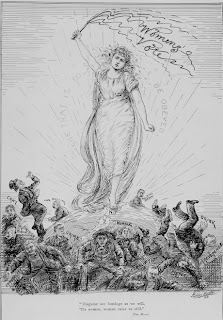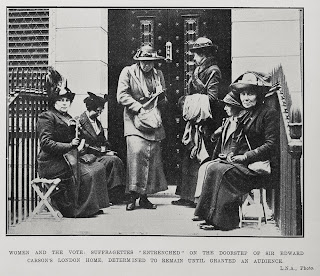The Womens Suffragette movement in NZ and Britain
The 19th September marks Suffrage Day in NZ. This year's anniversary is extra special, since it marks 120 years since Kiwi women won the right to vote in national parliamentary elections in 1893. The Governor, Lord Glasgow, signed the landmark legislation, which made the new Electoral Act into law. In doing so, NZ became the first self governing country in the world to give women this right.
Also of importance during 1893, was the election of the first female mayor in the British Empire. Elizabeth Yates became the Mayor of Onehunga Borough Council in 1893 and served until 1894. She also was a councilor from 1899 - 1901. Despite the sexism Elizabeth endured her time as mayor, she made a huge impact - reduced the debt of the council, kept the streets and footpaths
maintained and made an impression on Parliament when lobbying for
the Onehunga Cemetery Bill.
There was still a long way to go in NZ though, before the inequality imbalance started to shift. For example, it took another 26 years before women could stand for Parliament (1919), and it wasn't until 1933 when Elizabeth McCombs, the the first female MP was elected.
However, compared to the rest of the world, NZ was very progressive. In most self governing countries around the world including Britain and the United States, women had to wait until after First World War to get the right to vote.
During WW1, the British suffragettes stopped demonstrating and focused on the war effort. They made significant contributions to the war, which had the affect of gaining public support. In 1918, women over 30 gained the right to vote. The age restriction wasn't lowered until 1928, when it was changed to 21, the same voting age as men. Changes within government were slow and it wasn't until 1979, that trade union leader Margaret G. Bondfield, became the first female cabinet member. That year also, Margaret Thatcher became the first female Prime Minister of Great Britain.
The images below from Heritage Images database, show some of the the struggles that the British suffragettes went through in London, during the early 20th century.
1908:
1909:
1910:
1912:
1914:
Auckland Libraries holds a number of heritage resources relating to womens suffrage, which can be browsed by theme. These themes include: suffrage in NZ and Great Britain, Auckland indexes of women enrolled to vote in 1893 and suffrage monuments. There are also a number of letters in the Sir George Grey Special Collections relating to suffrage - these can be searched for through the Manuscripts Online database (just enter the search term suffrage). These include: a letter from Mary Cozens to Sir George Grey about the Parliamentary Committee for Women's Suffrage in 1895 (GL C57.2) and a letter from Helen Blackburn to Sir George Grey about the annual report of the Central Committee of the National Society for Women's Suffrage in 1894 (GL B38).
 |
| Ref: 7-A12543, A cartoon by Ashley Hunter on Women's Vote, 30 Sept 1893, Sir George Grey Special Collections |
 |
| Ref: 7-A12353, women voting at the Drill Hall in Rutland St, Auckland, 1899, Sir George Grey Special Collections |
However, compared to the rest of the world, NZ was very progressive. In most self governing countries around the world including Britain and the United States, women had to wait until after First World War to get the right to vote.
During WW1, the British suffragettes stopped demonstrating and focused on the war effort. They made significant contributions to the war, which had the affect of gaining public support. In 1918, women over 30 gained the right to vote. The age restriction wasn't lowered until 1928, when it was changed to 21, the same voting age as men. Changes within government were slow and it wasn't until 1979, that trade union leader Margaret G. Bondfield, became the first female cabinet member. That year also, Margaret Thatcher became the first female Prime Minister of Great Britain.
The images below from Heritage Images database, show some of the the struggles that the British suffragettes went through in London, during the early 20th century.
1908:
 |
| Ref: AWNS-19081210-6-5, suffragette cavalry in London, 10 December 1908, Sir George Grey Special Collections |
1909:
 |
| Ref: AWNS-19090211-2-1, the release of the suffragette leaders Mrs and Miss Pankhurst from Holloway Goal, London, 11 February 1909, Sir George Grey Special Collections |
1910:
 |
| Ref: AWNS-19100908-9-2, NZers inc. Dr Alice Burn and Lady Stout share in a great suffragette demonstration at Hyde Park, London, 8 September 1910, Sir George Grey Special Collections |
1912:
 |
| Ref: AWNS-19120418-11-2, suffragettes outside the Bow St Station, London, 1912, Sir George Grey Special Collections |
1914:
 |
| Ref: AWNS-19140416-48-6, suffragettes 'entrenched' on the doorstep of Sir Edward Carson's London home, 16 April 1914, Sir George Grey Special Collections |
 |
| Ref: AWNS-19140611-39-2, Suffragette Week in London, Irish ladies taking part in a procession through Piccadilly, London, 11 June 1914, Sir George Grey Special Collections |
 |
| Ref: AWNS-19140702-46-1, London suffragette holding onto the railings outside Buckingham Palace, London, 2 July 1914, Sir George Grey Special Collections |
 |
| Ref: AWNS-19140723-51-1, Miss Sylvia Pankhurst leaving the suffragette headquarters, London,, 23 July 1914, Sir George Grey Special Collections |

The 1893 Women's Suffrage Petition was inscribed on the UNESCO Memory of the World International Register for documentary heritage in 1997 and the New Zealand Register in 2011, acknowledging the significance of the Petition to New Zealand's heritage and today's society.
ReplyDeleteThe 1893 women's franchise petition is housed at Archives New Zealand, Wellington, along with a facsimile of the first sheet, bearing the signature of petition organiser and suffragist Kate Sheppard.
The high level of interest shown in the petition by New Zealanders and people from other countries who view it when they visit Archives New Zealand highlights the importance of the document to the world and the need to preserve it and allow people to learn about it and New Zealand through the register.
A microfilm copy of the full petition is available in Archives New Zealand's public reading room, along with an alphabetical name index of signatories and a transcript with geographical listings. For more information visit Archive New Zealand's website www.archives.govt.nz.